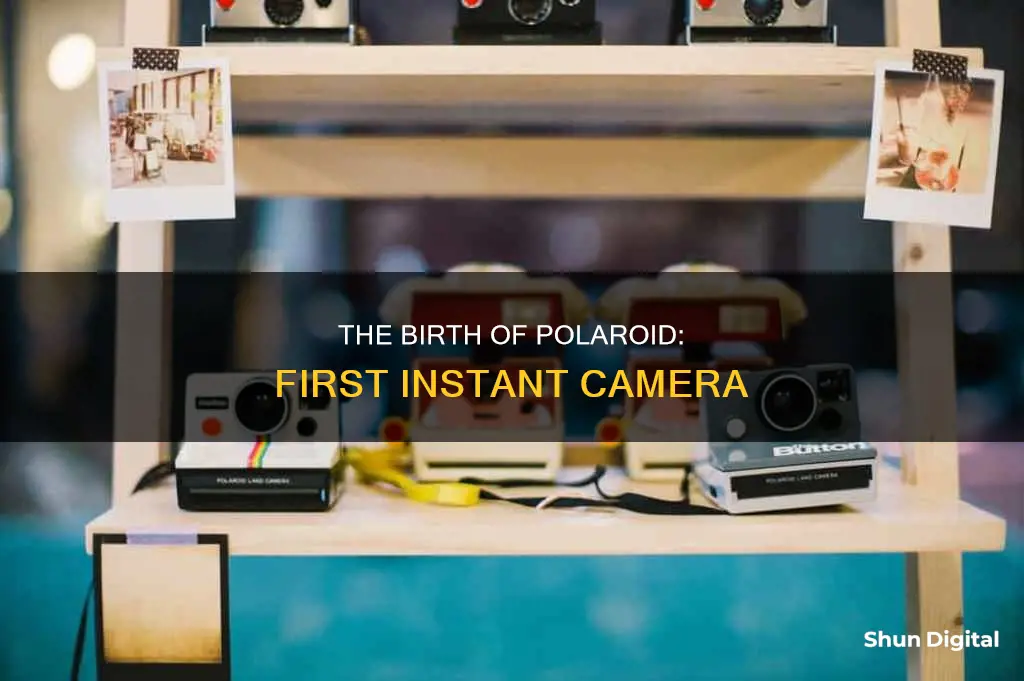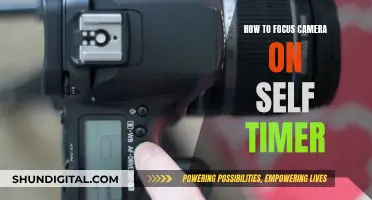
The first Polaroid camera was released in 1948, marking a pivotal moment in the history of photography. The brainchild of American inventor and physicist Edwin Herbert Land, the Model 95 camera debuted at a department store in Boston, selling out within minutes despite its relatively high price tag of around $90. This groundbreaking invention revolutionised the way people captured and experienced photos, eliminating the need for darkrooms and lengthy development processes.
| Characteristics | Values |
|---|---|
| Year the first Polaroid camera was made | 1948 |
| Inventor of the first Polaroid camera | Edwin H. Land |
| Company that made the first Polaroid camera | Polaroid Corporation |
| Name of the first Polaroid camera | Model 95 Land Camera |
| Date of the first public demonstration of the first Polaroid camera | 21st of February 1947 |
| Location of the first public demonstration of the first Polaroid camera | Meeting of the Optical Society of America, New York City |
| Number of cameras initially produced | 50 |
| Store that first sold the first Polaroid camera | Jordan Marsh department store, Boston |
| Price of the first Polaroid camera | $90 |
| Colour of the first prints | Sepia |
What You'll Learn

The first Polaroid camera was released in 1948
The debut of the first Polaroid camera, known as the Model 95, occurred at a department store in Boston. Within minutes, the camera sold out, despite its relatively high price tag of around $90. This initial success set the tone for the camera's popularity, as customers embraced the convenience of nearly instant results.
The Model 95 employed a unique process to develop photographs. It held two sheets of photo paper, with an exterior knob that turned interior rollers to push the sheets together. As the sheets pressed together, development chemicals were released between the layers, taking about a minute to develop before the layers could be peeled apart to reveal the image.
The impact of the first Polaroid camera extended beyond its initial release. In 1950, a true black-and-white version was introduced, followed by colour film in 1963, marking key milestones in the evolution of instant photography. The Polaroid camera's ability to produce instantaneous results captivated the public, shaping the future of photography and cementing its place in the industry.
The Wyze Camera Battery: How Long Does It Really Last?
You may want to see also

The camera was called the Model 95
The Model 95 was an instant success, selling out within minutes of its release. This initial success would be the first of many for the Model 95, which would go on to become a cultural icon. The camera's ability to produce photographs in under a minute was revolutionary for its time, capturing the public imagination and changing the world of photography forever.
The Model 95 was the culmination of years of work by American inventor and physicist Edwin Herbert Land. Land's interest in instant photography was sparked by a question from his three-year-old daughter, Jennifer, who asked why she couldn't see the pictures he had just taken of her. Land's subsequent invention of the Model 95 would change the course of photography, making it possible for anyone to capture and hold a photograph in their hands almost instantly.
The Model 95's impact extended beyond its technological innovations. It played a pivotal role in democratising photography, putting high technology into the hands of consumers. No longer was photography limited to professionals or enthusiasts with access to darkrooms and complex equipment. The Model 95's ease of use and convenience captivated the public, leading to the widespread adoption of instant photography.
The Model 95's influence also reached the world of art, with Polaroid partnering with renowned artists and photographers. Polaroid provided artists with free cameras and film, in exchange for feedback and photographs. This collaboration resulted in a vast collection of artistic Polaroid photographs, with contributions from masters such as Ansel Adams, William Wegman, and Andy Warhol.
The Model 95's legacy is enduring, with its impact still felt today. It laid the foundation for the instant photography movement, which continues to captivate and inspire generations of photographers and artists. The Model 95's influence can be seen in the resurgence of instant cameras and the nostalgia for antiquated technology. It remains an iconic symbol of the golden age of instant photography, a testament to the genius of Edwin Land and the power of innovation to transform our world.
Waylens Camera: Exploring USB Mode Functionality
You may want to see also

It was the first commercial instant camera
The first Polaroid camera, the Model 95 Land Camera, was released in 1948. It was the first commercial instant camera. The camera was put on sale at the Jordan Marsh department store in Boston, and sold out within minutes. The camera retailed for about $90, a relatively high price tag, but customers couldn't get enough of the nearly instant results.
The Model 95 held two sheets of photo paper at opposite ends of the interior camera body. An exterior knob turned a pair of interior rollers, which pushed the sheets together before expelling them from the camera. As the sheets pressed together, development chemicals were pressed between the layers. These chemicals took about a minute to develop the photo before the layers could be peeled apart and the image revealed.
The Model 95 was the first commercial instant camera, but the technology behind it had been in development for several years. The process of instant photography was first demonstrated by the camera's inventor, Edwin Land, at a meeting of the Optical Society of America in February 1947. The idea for the camera came to Land in 1943, when his three-year-old daughter, Jennifer, asked why she couldn't see the pictures he had just taken of her. Land set about creating a camera that developed film internally and produced a finished photograph almost instantly.
Evernote Camera Mode: How to Switch and Use It
You may want to see also

The camera sold out on its first day
The first Polaroid camera, the Land Camera Model 95, was released in 1948. It was a huge success, selling out on its first day. The camera was initially stocked at the Jordan Marsh department store in Boston, with a small run of only 50 cameras. Despite the high price tag of about $90, every single one of those cameras sold on the first day.
The Model 95 was an instant hit, capturing the public imagination with its promise of nearly instantaneous results. The camera held two sheets of photo paper at opposite ends of its interior body. An exterior knob turned a pair of interior rollers, pushing the sheets together and expelling them from the camera. As the sheets pressed together, development chemicals were pressed between the layers, creating a photograph in about a minute.
The Model 95's success was a testament to the public's desire for instant photography. This desire was first sparked by the camera's inventor, Edwin Land, who, while taking pictures of his daughter in 1943, wondered if it were possible to create a camera that developed film internally and produced a finished photograph almost instantly. Land's curiosity and ingenuity led to the development of the Model 95, which revolutionized the photography industry and cemented Polaroid's place in history.
The Model 95's popularity also highlighted the public's willingness to embrace new technology. Despite the camera's unique development process and the relatively high price, consumers embraced the Model 95, eager to get their hands on the latest innovation in photography. This willingness to adopt new technology has continued to shape the industry, with digital cameras and smartphones eventually overtaking Polaroid as the preferred choice for capturing images.
The success of the Model 95 also demonstrated the power of innovation in driving commercial success. Polaroid, led by the visionary Edwin Land, was a pioneer in its field, constantly pushing the boundaries of what was possible in photography. This spirit of innovation not only brought convenience and excitement to consumers but also drove the company's success and helped it secure a dominant position in the market.
Camera Raw Versions with Adjustment Brush
You may want to see also

It was invented by Edwin Land
The first Polaroid camera was invented by Edwin Land, an American scientist, inventor, and physicist. Land was a prolific inventor, acquiring over 500 patents during his life—only a few spots below Thomas Edison on the American scoreboard.
Land's interest in light and its manipulation through engineering began when he was just 13 years old, playing with the idea of polarizing materials to reduce glare from lights. By the 1930s, he had created synthetic polarised materials for the commercial market. In 1932, he partnered with George Wheelwright to create the Land-Wheelright labs to manufacture his polarizers.
Land's focus shifted to instant photography in 1943 when, while on a family trip, his three-year-old daughter, Jennifer, asked him why she couldn't see the picture he had just taken of her. This sparked the idea for a camera that developed film internally and produced a finished photograph almost instantly. Within a few years, Land had built what was essentially a darkroom in a box.
The first Polaroid camera, the Land Camera Model 95, was unveiled at a meeting of the Optical Society of America in February 1947. The following year, in 1948, it went on sale to the public. Initially, only 50 cameras were produced and stocked at the Jordan Marsh department store in Boston. Despite the high price tag of about $90, every camera sold on the first day.
The Model 95 held two sheets of photo paper at opposite ends of the interior camera body. An exterior knob turned a pair of interior rollers, which pushed the sheets together before expelling them from the camera. As the sheets pressed together, development chemicals were pressed between the layers, creating a photograph in about a minute.
Charging the Apeman Action Camera: A Step-by-Step Guide
You may want to see also
Frequently asked questions
The first Polaroid camera, the Model 95 Land Camera, was released in 1948.
The Model 95 was the first commercial instant camera. It took about a minute for the photo to develop, which was significantly faster than the existing photo development infrastructure at the time.
The inventor and founder of the Polaroid Corporation, Edwin H. Land, developed the first instant camera.







